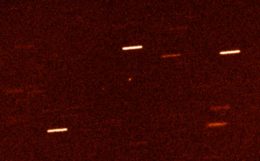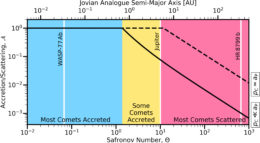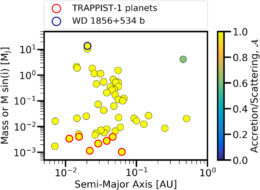Gravitational nudges can dislodge comets from the icy outer regions of a planetary system and send them on a collision course with the system’s planets. What kind of planets are likely to ensnare these inbound comets, and which are likely to wave them away?
Comets on the Move

The interstellar object ʻOumuamua is the dot at the center of this five-minute exposure taken with the William Herschel Telescope. Due to the object’s high speed, the other sources in the frame appear as streaks of light. [Alan Fitzsimmons (ARC, Queen’s University Belfast), Isaac Newton Group]
But the same gravitational interactions that can launch comets into interstellar space can instead send them careening into the inner regions of the planetary systems where they were born. When that happens, the comets can settle into new orbits, be consumed by their host star, or, as a new publication explores, be accreted by the planets in the system. What determines whether a planet will collect comets that wander close to it, and how might the accretion of comets affect our interpretation of exoplanet spectra?

The ratio of accreted comets to scattered comets as a function of the Safronov number, which increases with the mass and orbital distance of the planet and decreases with the mass of the host star and the radius of the planet. This plot shows the results for a Jupiter-size planet orbiting the Sun at varying orbital distances. Jupiter, WASP-77 Ab (a hot Jupiter), and HR 8799 b (a directly imaged planet) are marked on the plot. Click to enlarge. [Seligman et al. 2022]
Accreted or Scattered?
A team led by Darryl Seligman (University of Chicago) developed a set of equations that predict which planets are most likely to accrete inbound comets. The equations describe the likelihood of a planet accreting a comet into its atmosphere or scattering a comet into a new orbit (or out of the system entirely) as a function of the properties of the planet — its mass and orbital distance — and those of the comet — mainly its eccentricity, which is a measure of how circular or elongated its orbit is.
The team used their metric to determine which of the previously detected exoplanets are likely to have added cometary material to their atmospheres. Seligman and collaborators found that, in general, planets categorized as warm Jupiters, super-Earths, and sub-Neptunes are more likely to ensnare passing comets than colder, more massive planets.
Composition Imposition

The ratio of accreted to scattered comets for many of the exoplanets to be observed by JWST. [Seligman et al. 2022]
Seligman and collaborators note several reasons that their estimates are likely an upper limit on the amount of cometary material that planets accumulate. For example, if comets in other planetary systems tend to disintegrate or lose their volatile compounds quickly, the likelihood of exoplanet–comet encounters — and the effect they have on an exoplanet’s atmospheric composition — could drop.
This issue is a timely one, since based on the team’s metric, nearly all of the exoplanets that JWST will observe within the next year have the potential to have accreted cometary material.
Citation
“Inferring Late-stage Enrichment of Exoplanet Atmospheres from Observed Interstellar Comets,” Darryl Z. Seligman et al 2022 ApJL 933 L7. doi:10.3847/2041-8213/ac786e
